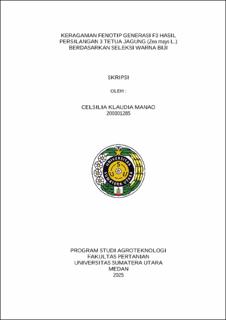| dc.description.abstract | Corn crops are the main commodity in the role of food supply in Indonesia, corn is the second strategic after rice commodities. There are several types of corn that can be consumed and processed, such as sweet corn, glutinous corn (white kernel) and purple corn (purple kernel). This study aims to find out the diversity of F3 generation phenotypes by crossing 3 corn elders based on seed color selection. This research was conducted at the Kassa House of the Faculty of Agriculture, University of North Sumatra with an altitude of ± 32 meters. This study was conducted between April 2024 and July 2024. This research was conducted using the grid method. It has 10 lines with 10 samples for each line. The corn seeds used are purple and white seeds with 50 seeds each for purple corn and 50 seeds of white corn. The study used a visually descriptive method. Research results show that high heritability values are found in male flowering age characters, female flowering age, plant height, cob diameter, cob length, number of rows per cob, and cob weight. Meanwhile, the highest value of the Fenotip Diversity Coefficient (KKF) is found in the age character of the harvest, which is 92.5%, showing wide and diverse variability. Observation of the color of corn seeds results in three categories: purple, red, and mixed (purple and white) with a percentage of variation in the color of the seeds being 8.6% for red seeds, 20% for purple seeds, 28.6% for purplewhite dominant seeds, 40% for white (white-purple) and 2.9% for mixed (purplewhite) seeds. Visually, male and female flowers are categorized as purple, white, purplish white, and red. | en_US |


